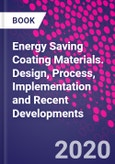Energy Saving Coating Materials: Design, Process, Implementation and Developments provides comprehensive information regarding recent materials advancements and design aspects and integration for infra-red radiation regulators, along with future developments of zero emission buildings. The key opportunities and challenges for the usage of existing heat regulation materials and their implementation for commercial aspects are explored. The fundamental interaction between electromagnetic waves and materials are discussed, along with materials synthesis, design and integration of coatings for smart window applications. This book presents recent developments of innovative technologies comprising energy saving materials and coatings which are key considerations for achieving vital energy saving milestones.
Please Note: This is an On Demand product, delivery may take up to 11 working days after payment has been received.
Table of Contents
1. Solar radiation and light materials interaction 2. Infra-red (IR) radiation and materials interaction: Active, passive, transparent and opaque coatings 3. Transparent heat regulation materials and coatings:� present status, challenges, and opportunity 4. Dielectric/metal/dielectric (DMD) multilayers: growth� and stability of ultra-thin metal layers for transparent� heat regulation (THR) 5. Novel materials and concepts for regulating infra-red radiation: radiative cooling and cool paint 6. Understanding spectrally selective properties of solar absorbers 7. Metal oxides and metal thin films by atomic layer deposition (ALD), liquid-ALD, and successive ionic layer adsorption and reaction� methods for THR applications 8. New paradigm for efficient thermoelectrics 9. Design of thermochromic materials and coatings� for cool building applications 10. Recent developments in smart window engineering:� from antibacterial activity to self-cleaning behavior 11. Upconverting nanoparticles: potential for a new heat regulating materials 12. Machine learning approach for materials technologies 13. Roadmap for materials selection and energy saving coatings








